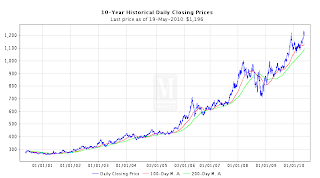I also can't wait to see the price of gold fall. It is obviously far to inflated and has been increasing in value due to speculation and market volatility. I never understood why it became so popular? If people wanted safer waters during the great recession, why not purchase bonds or t-bills with a guaranteed rate of return instead of a commodity highly susceptible to speculative price inflation.

I suppose what it comes down to is my view that markets, while rational in times of relative stability, are susceptible massive irrationality or behavior in times of economic uncertainty. Just as a herd of water buffalo will trample each other at the first sign of a lion, markets will over speculate prices causing massive bubbles and busts. Take for instance the Mandelbrot study of cotton prices over a period of time, he came up with fat tails. According to rationalists, markets should fall neatly into rational models.
On average, the market will move a little up, a little down, or stay about the same. Of course there will be days where the markets surges or plunges, but thats ok because this is a rarity and according to the law of large numbers, should only occur once in a blue moon. But to have consecutive days, weeks, months of massive drops is somewhere in the neighborhood of 27 standard deviations out of the bell curve. Imagine flipping a coin 5,000 times and getting heads every time. Now look at the model below, the top represents the fat tails that Mandelbrot warned us about and the bottom represents a rational market, which one looks more like the Dow?
If anything can be learned it's that prices will never continue to rise without speculation fueling a boom and bust. When the boom comes, people will trample each other to ride the surging prices for ever increasing profits and when prices began to come down the selling will rocket prices to artificially low levels.
Just some musing about the economy... thanks for sticking with me on this one.
Dutch Man
0 comments:
Post a Comment